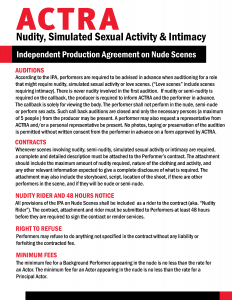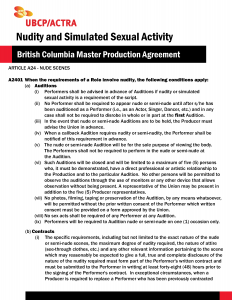Safe Sets
It is the responsibility of every performer to take an active role in their own health and safety. While there are guidelines and regulations in place that demand producers to be vigilant, it is up to everyone to ensure the set is a safe working environment. Don’t be shy – if you see something that looks questionable – speak up, your life might depend on it!
Keep your eyes open and stay alert. Notify someone on the crew if you see something that looks unsafe. Ask questions if you are unsure of your situation or responsibilities. Identify the Crew Health and Safety Rep. and any Stunt Coordinator listed on the call sheet.
You have rights. They are set out in our collective agreements and most provinces have standard employment health and safety laws. Become familiar with them.
Here are some specific areas of concern to performers on a film set and what you can do to protect yourself:
Slip and Fall Accidents
- These make up most of all workplace injuries.
- Exercise caution around Honey Wagons, bathrooms and loose cables.
- Be careful on stairs and when crossing roads or highways.
Environmental Illnesses
- Wear proper (seasonal) clothing/footwear. Bring layers to cover up with between takes.
- Drink plenty of water.
- Wash your hands frequently & demand clean, accessible toilet facilities.
- Watch to see that Makeup and Craft Service personnel are following reasonable hygienic procedures.
- Be careful and ask questions when working with “smoke” or artificial snow on a set.
- Water should be clean and of a reasonable temperature. Insist on proper water wear for conditions and an opportunity to warm up between takes.
- Be cautious around propane heaters. They are not to be utilized in an enclosed space.
Allergies and Medical Conditions
- It is your responsibility to make production and the crew members specifically involved aware of any allergies (e.g. food, makeup, animals), chemical sensitivities, phobias or medical conditions (e.g. epilepsy, chronic back pain, heart condition) that may be triggered by the set environment.
Physical Injuries
- Be alert around heavy equipment (e.g. cranes, set structures, overhead lights and flags).
- If you’re in the shot, ask if you can attend the on-set safety meeting when a stunt is to be performed whether you’re doing the stunt or not.
- Be aware of when and where firearms, explosives, pyrotechnics, open flames, helicopters, wind machines and the like will be used on set. Make being safe your number one priority.
- Watch for laser measuring devices being used by focus pullers and other crew members. Ask if they are in use on set and avoid looking directly at them.
Vehicle Safety
- Wear seat belts!
- Don’t over-estimate your driving skills. If you’re not a “professional” stunt driver, let someone else drive.
- If you’ve never ridden a motorcycle or driven a boat, the set is not the place to learn. Again, leave it to the professionals.
Animals
- Animal actors are specially trained. Do not approach them without the trainer’s permission and supervision.
- If you’re in a scene with an animal, talk to the trainer. Learn all you can about your fellow actor before someone calls “Action!”
Children
- Special regulations exist in the IPA and NCA to protect child actors. Do not bend the rules to please production. The turnaround times and work-day regulations were hard fought and are for the benefit of these vulnerable performers.
What is a stunt?
- A stunt is a performance that would be considered dangerous if not performed by someone with special training or is beyond a performer’s general experience or abilities and would therefore place them at risk of injury.
- A Stunt Coordinator is the best person on the set to decide whether any particular performance is a stunt and should be subject to a stunt fee.
- If there is no Stunt Coordinator on set and you feel it would be unsafe for you to attempt the performance that is being requested of you, you should let production know of your concerns and suggest they get a qualified stunt performer to do the performance.
- Be aware that long-term, career-ending injuries can result from poorly performed or dangerous stunts. Proceed with caution.
- Note: an increase in your fees will not make the performance any safer!
If you are injured or become ill on set (“set” includes all areas of the actor’s workplace):
- REPORT THE INJURY immediately to the closest AD and the Crew Health & Safety Rep.
- See the set nurse or medic when available.
- Go to the hospital! Even small injuries can have dire consequences.
- Complete documents to protect yourself for any future insurance claim. These may include an Accident Report, a WSIB Report and a Police Report (for auto accidents).
- Take down your own detailed notes, names and observations.
- Call the ACTRA Representative responsible for the production and give them copies of all documentation.
- See your family doctor as soon as possible. Get a letter describing your condition.
If you find yourself sick or injured a few days after an incident on set, see your family doctor immediately and notify the ACTRA Representative responsible for the production.
Your health and safety should be your primary concern. Most crew professionals will go out of their way to create a safe set. As actors, we have more time to stand around and observe. So, if you notice something you feel is unsafe, notify a crew member. Be helpful, respectful and patient and most problems will be resolved quickly and to your reasonable satisfaction.
Nudity
Understanding scenes involving nudity, simulated sexual activity & intimacy under the Independent Production Agreement (IPA) and the British Columbia Master Production Agreement (BCMPA). Download the guide by clicking on an image below:



